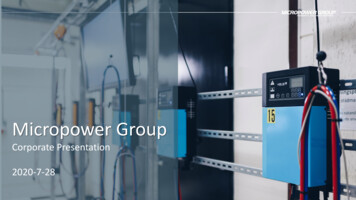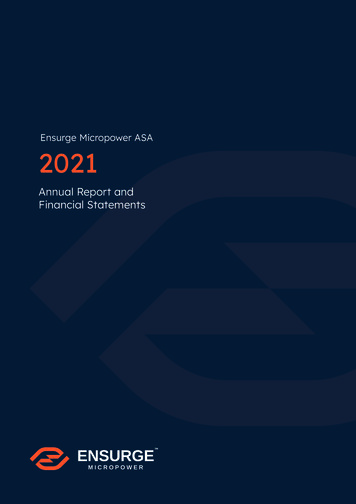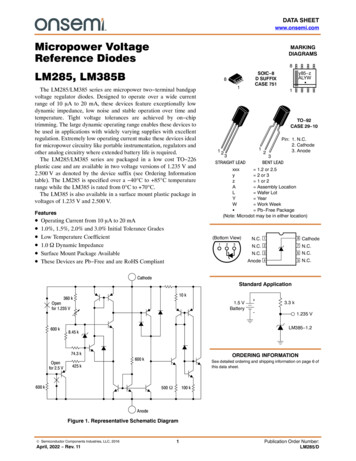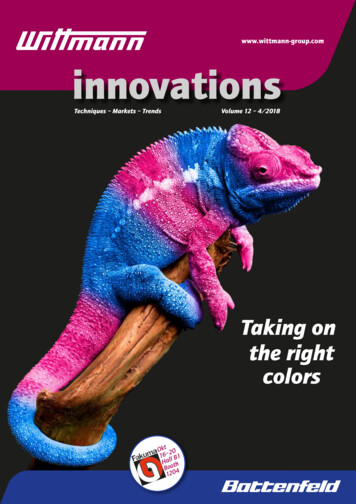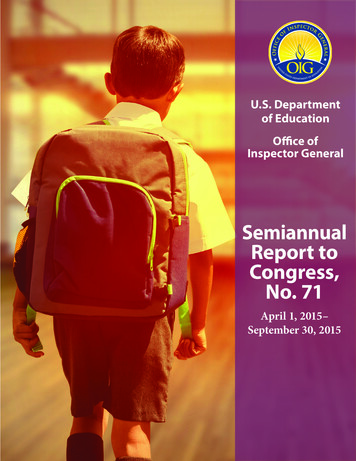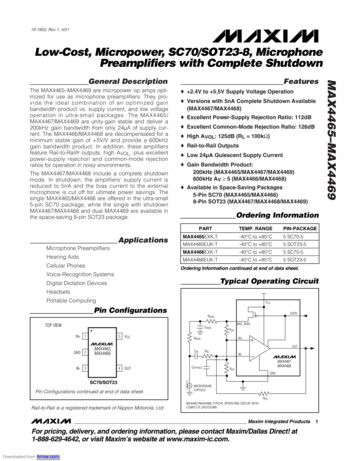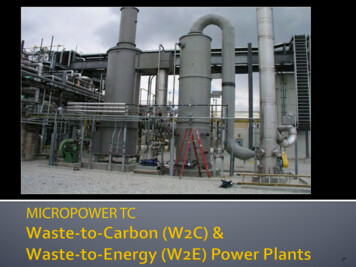
Transcription
MICROPOWER TC!"
Enormous“WasteandEnvironmental”Challenges mous“Energy”Challenges te- ‐of- ‐the- rbon(W2C)andWastetoEnergy(W2E)Platforms
teB e v e r a g e 1TonofMSW 480kWhto550kWho cofeMsSWs i navoidsgimporting0.75to1Barrel P1TronWaste(30to42gallons)ofoil 1TonofMSWavoidsmining1/3rdto1/4thtonofcoal 1TonofMSWavoids1.3TonsofCO2
nPrimarySecondary AgriculturalWaste ForestryWaste WoodWaste YardWaste FoodandFoodProcessingWaste Biocarbon Biocoke BiocharorBiocoal CarbonBlack Bioenergy(Power) SterileAshFOCUSSolidWaste MunicipalSolidWaste Tires SewageWaste LiquidWaste MedicalWaste ry Bioenergy(Power) SterileAsh Biocarbon Biocoke BiocharorBiocoal CarbonBlackEnergy
CoreGuidingPrinciples Reposition over reatthemasAssetsratherthanliabilitiesTransform &EnergyRestore BiomassWasteCarbon(W2C)
Rising demand for low carbon power driving investment worldwide Over 9 billion was invested in new build waste to power facilities in 2010, largely in Brazil,Europe, and Asia. China is currently the largest investor in the sector with over 70% of newcommitments in H2 2010. According to the latest IEA assessment, global biomass and waste to power generation capacityis expected to grow 6% annually thru 2035 with 30GW of new generation capacity forecast for theUS alone.Biomass and Waste to Energy New BuildInvestment(source Bloomberg New Energy Finance)108 Billions(source IEA's WEO2010 Forecasts)300Electricity Capacity (GW)12Global Biomass and Waste to Power 007200820092010200820152020202520302035
drivingopportunitiesintheUS Thenumber of waste to power facilities in the US has fallen from over 180 in the 1980s to around 90today due to a heavy historical reliance on dirty, inefficient incinerators that can no longer meet emissionstandards. Tippingfees for municipal solid waste (MSW) are continuing to rise in line with EPA forecasts for wastegeneration, creating an opportunity to lock in long-term inflation adjusted contracts for MSW feed stocks.New MexicoTexasFloridaKansasMontanaCaliforniaSouth DakotaIllinois220Oregon230New rce Individual State Environment Agencies, 01220132014201520162017201820192020Million tonnes290 100 90 80 70 60 50 40 30 20 10 0New Hampshire(source EPA)Vermont MSW300Mean US State Landfill Tipping Fees per ton,2008New Jersey MSWUS municipal Solid Waste Generation andProjections
s120%100%80%60%Waste- ‐to- te- ‐to- ‐EnergyIndustryprojectedtobe 28.8Billionby2015!0% 87W2EplantsWesternEurope 400W2EPlantsAsia 300W2EPlants
Currently87W2EplantsinUSin31states Mostlycombustionplantswith20- ‐25 year-oldtechnology Processonly12- city LaggingbehindJapanandEurope Expensive - ‐ Higher theartWasteTransformationPlatforms
MICROPOWER TCIncinerationAnaerobicDigestionArc PlasmaProcessDescriptionWaste feedstock is convertedat moderate temperatures withcontrolled amount of oxygen toproduce syngasWaste fuel is directly combustedto produce heatBiodegradable waste isbroken down by microorganisms to produce amethane rich biogasWaste feedstock is converted atvery high temperatures withcontrolled amount of oxygen toproduce syngasScaleDecentralized, 300tpd,scalable modular 10-12 MWunits, small footprint, 37- 41 MM/facilityto scale under 50MW, largefootprint, requires large amountsof waste, 250-500MM/facility1MW, large footprint, 15-20MM/facilityConversion90% of energy content ofwaste is used to makeelectricityLess than 60% of energycontent of waste is used tomake electricityLess than 35% of energycontent of waste is used tomake electricityLess than 50% of energycontent of waste is used tomake electricityExternalFuel SourcePowered by self-generatedclean energyTypically powered by fossil fuelsreducing net energy outputLow operational powercostsTypically uses high voltageelectrical power from the gridreducing net energy outputEmissionsSurpasses all US andEuropeanAir Quality StandardsPollution-laden processrequiring large investment inpollution controlOdor issues a persistentproblem for localcommunitiesCumulative emissions tend tobe high due to the size of thefacilitiesProcess ByproductWaste is reduced 98% withsterile bottom ash being theonly by-productWaste is reduced 70% with toxicash and slag still requiringdisposalDecentralized, 100tpd,Waste largely remains into scale under 50MW, largefootprint, 400-500MM/facilityWaste is reduced by 90% with adense, solid slag materialremaining
State- ‐of- ‐the- ‐Arttechnology rocess Oxygen-Starved RunsClean 98%volumereduction(forW2Esystems) 2%SterileAshwithoutanydross,clinkersorslag Canbeusedasvaluablebyproduct ResourceRecovery Allferrousandglassmaterialsrecycledafterprocessing bustionorIncineration
MICROPOWER TC Advanced W2EGasification TechnologyStep 1 - MSW is loaded at a waste-to-energy plant into 25ton (50 tons/day) advanced, specially designed wastetranformation modules;Step 2 - The waste is then heated and then gasified (cookedslowly) in an oxygen starved, pressure and temperaturecontrolled, fully automated environment to chemicallytransform the waste to energy-rich syngas and sterile ash(2% to 10% of original volume);Step 3 - Syngas is then cleaned and ignited into a conventionalwater tube boiler to generate steam;Step 4 - Steam then turns a turbine and generates cleangreen energy"
MICROPOWERTC Process eratorCondensingWaterReclaimSystemEnergy alYardwastePlastic ELECTRICITYEXPORTED TOLOCALDISTRIBUTION NETWORKHeatExchangerParticulateRemoval SIMOFeedstockHEAT ANDPOWER TOINUSTRIAL nControlEnergyOutputCarbonProductsSterileAsh JOB CLIENT Slow,ModerateTemperature TwoStage,Pyrolytic/GasificationTechnology 4000C–5000C,10000C–12000CTITLE DRAWING DRAWN SCALE REVTITLE DESCRIPTION DATEBY SHEET DRAWINGNUMBER REVISION
MICROPOWER TC Technology The waste transformation process starts with untreated municipal, industrial, forestry, agricultural or medical waste beingbulk-loaded into the waste processing modules. Once loading is complete, the gasification process occurs in the absence of oxygen at the relatively moderatetemperatures of 600-800 C. The modules automated control system uses over 600 sensors to monitor temperature,emissions, airflow, and pressure during the conversion process. The waste is reduced by 98 percent, leaving only a residue of sanitized, non-toxic sterile fly ash that can then be soldas an additive for concrete or as an amendment for emNon- ‐toxicSterileFlyAsh
MICROPOWER TC TechnologyFlyAshVacuum Although the waste is processed in an undisturbed state,small particles of fly ashand other impurities may existwithin the syngas and need tobe removed. The MICROPOWER TC technologyuses a Venturi Cyclone tocondition the syngas, which relieson particle density and velocityto separate out the fly ash andother impurities. Filters may also be used tocapture the smallest of particlesin order to enhance the quality and combustibility of thesyngas.Micropower CorporationAllRightsReserved.VenturiCyclone
MICROPOWER TC TechnologyFirePackagedWatertubeBoiler During the steam productionphase, the syngas is ignited andthe heat is transferred through thewalls of sealed water tubes toproduce steam. The boiler also recovers heat fromother areas within the system topreheat the water source,increasing system output. The steam produced by thewatertube boiler is thenpressurized and superheated toturn the steam turbine andproduce electricity.Micropower CorporationAllRightsReserved.
MICROPOWER TC TechnologyMICROPOWER TC Thermal Oxidizer The Packed Bed Scrubber, orThermal Oxidizer, is designed toremove gaseous or vaporouspollutants from an air stream. The process is accomplished bycontacting the contaminated airstream with a scrubbing liquor thatabsorbs or chemically reacts with thepollutants. The cleaned air is then discharged tothe atmosphere and the contaminatedscrubbing liquor is either disposed ofin an approved manner or recycled.Micropower CorporationAllRightsReserved.
MICROPOWER TC TechnologySteamTurbineGeneratorSet During the energy output phasethe steam turbine generator setproduces electricity that is thenexported to local distributionnetworks. The output can also be exportedas heat to local industrial users. The system's heat exchanger alsoworks to capture any residual heatfrom the waste stream so that itcan be looped back into thesystem.Micropower CorporationAllRightsReserved.
ROPOWER TC Rentech Thermal OxidizerSystem org/docs/epaletter.pdf)
cessing Modular Scalable Adaptive BaseModul 50TPD W2C- ‐StandardSystem150- ‐200TPD W2E–StandardSystem200- ‐300TPDW2C/W2EPlatform SmallFootprint 10,000sqft/module Decentralized Distributed OptimizedforLowCost&Efficiency LongLife Automated Controlled Monitored Sustainable Environment-FriendlyValuableBioProducts PerModule 25- ‐30TPDBiochar 25- ‐30TPDBiocarbon 25- ‐30TPDBiocoke 20- ‐25TPDCarbonBlack PerSystem 75- ‐120TPDBiochar/Biocoke/Biocarbon 60–100TPDCarbonBlack W2C- ‐2MW W2E–10MW! 98%Conversion 2%SterileAshCarbon/Energy
Biochar/Biocoal SoilAmendment Cooking SequesteringCarbon Co- ‐firing 100- ‐ 200/Ton)(forsoilamendment)Biocoke Replaceupto20%ofBituminousCokeforGHGReduction FuelforSintering&Pelletizing Reductant 200- ‐ 300/Ton) 200- ‐ carbon Mercuryscrubbingfromcoalfiredpowerplants GasandChemicalRefinement Metalextraction 250- ‐ 500/Ton(readytobeactivated)CarbonBlack OTn- s FTeed- ‐inonersT,arffInk&Paints NmeteringPetlasticindustryBioenergy/Power On- ‐GridPowerGeneration Feed- ‐inTariff NetMetering 400- ‐ 800/Ton 60- ‐ ities 500- ‐ tration
TippingFees* MSW 25- ‐ 30/Ton Tires 70- ‐ 80/Ton WoodChips 25- ‐30/Ton SludgeCake– 50/Ton OthersVaryValuableByproducts Biocarbon(ReadytobeActivated) Biocoke Biochar CarbonBlack Power SterileAsh 10- ‐ 20/Ton FerrousMetals- ‐VariesInvestmentCredits InvestmentTaxCredit(ifapplicable) CarbonCredit RenewableEnergyCertificates(REC) Others AttractiveFinancialModel(2keycomponents) modelforUS
asicSystemCost( mm)1029SiteDevelopmentCost InstallationCost( mm)466- ‐MonthsWorkingCapital( mm)11TotalCost( od3- ‐5Years3- ‐5Years Requires edtowardsthefinalpurchase sanddurationdependsoneachspecificsituation
Economic LowCostFlexibleWasteProcessing chnology Biochar,Biocarbon,Biocoke,CarbonBlack&Bioenergy Modular,AdaptiveandCustomizableperSite SmallFootprint LocatedClosetotheSource MeetsorBeatsallEPAEmissionStandards onPlatforms
Precedent-SettingEnvironmentally BestPractices High- *December5,2011,High- AIC
MICROPOWER TC Build Out MethodologyPlanReadinessAssessment Questionnaire Preliminaryfeedstocktesting Preliminarysystemconfiguration Finalreviewoffinancialmodelandpro- ‐forma StatementofworkissuedDiscoveryandDesign Full- ‐scalefeedstocktesting Sitereviewandanalysis Engineeringandconstructionrequirements SystemConfigurationandcustomizations ProjectplanDeliverPre- ‐configurationandStaging Planningandscheduling Facilityconstructionandprocurement Fabrication Pre- ‐testingandqualityreview Factoryacceptancetesting Breakdownandpackaging ShippingandlogisticsInstallationandTraining Siteassembly Feedstockproductiontesting Performancetesting Systemcertification Systemandoperationstraining SystemmaintenancetrainingSystemAcceptanceandGo- ‐Live Finalqualityreview Systemsign- ‐off Systemgo- ‐live ProductionSupportSystemCare TechnicalSupport ServiceandMaintenance Upgradesandadditions
NextGeneration,State- ‐of- ‐the- endlyDesignedtoAddressEnormous ProblemofIncreasing Waste& uritySmallFootprint- l- ‐QuickReturnonInvestment Break-Even Period3to5yearsRepositionTransformRecoverRestore29
MICROPOWER TC Incineration Anaerobic Digestion Arc Plasma Process Description Waste feedstock is converted at moderate temperatures with controlled amount of oxygen to produce syngas Waste fuel is directly combusted to produce heat Biodegradable waste is broken down by micro-
